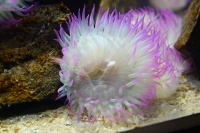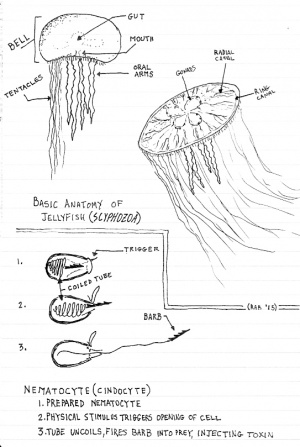AY Honors/Porifera and Cnidaria/Answer Key
Skill Level
2
Year
2012
Version
27.12.2025
Approval authority
South American Division
1
The Porifera, or sponges, are multicellular filter-feeders, drawing particles out of the water column and ingesting these for nutrients. The general action of sponges, then, helps categorize them as animals, rather than as plants. However, some scientists argue that Sponges may belong in their own kingdom, due to some unique characteristics. These include the ability of many sponges to group from single cells, forming back into the full set of differentiated cells of a sponge, and the fact that isolated sponge cells cannot live alone for long (unlike colonial animals, like bryozoans, which are cooperative cells, but not necessary to one an other).
2
Sponges have pores (called Ostia) which allow water to pass into their structure, drawn by the action of flagellum on specialized cells (Chanocytes). These Chanocytes are ringed with smaller hair-like structures that filter particles out of the water column, moving these particles into the sponge. Specialized cells (Amebocytes) move within a jelly-like matrix between the outer and inner “skin” of the sponge, and carry out digestion. These cells can also replace other cells, changing form and function as needed. The water that was drawn in the Ostia flows back out another pore, the Osculum.
3
Sponges are multicellular animals with an outer and inner membrane (the Ectoderm and Endoderm respectively), with a non-cellular jelly-like matrix between these cellular layers. Sponges have specialized Chanocytes, cells with a flagellum to create a current to draw water over special hair-like projections in a ring around the flagellum. Sponges gain structural strength from spicules, which in some form a type of skeleton. Spicules can be made of protein fibers, silica (glass) or calcium carbonate. Sponges are sessile, they do not move (though certain embryonic stages are capable of movement). Sponges do not necessarily have any particular symmetry to their body form.
Some examples of sponges, sponge skeletons and fossilized sponges: A bath Sponge, with protein spicules, the framework skeleton of a Glass Sponge, with silica spicules, and two different shapes of sponges preserved as fossils.
4
Cnidaria stems from the greek word meaning “nettle,” a reference to their sting. The Cnidaria include Jellyfish (Scyphozoa), Anemones and Corals (Anthozoa), the Hydras and the box jellies (Cubozoa). Cnidaria share several common characteristics. They are radially symmetrical, are composed of two layers (Ectoderm and Endoderm) filled with a jelly-like substance, are multicellular, and have stinging cells (Cnidocysts), which contain a harpoon-like Nematocysts. Cnidaria have a general mouth-like opening with a very simple digestive tract.
Examples of True Jellies (Scyphozoa): The Atlantic Sea Nettle, a jellyfish showing clearly the oral arms and the radial and ring canals, two examples of Upside-Down Jellyfish, and two examples of fossilized jellyfish impressions, the first from Texas, the second from Australia.






Anthozoa (Corals, Anemones and the like). A Mushroom Coral, a Clonal Anemone, and another anemone.



Hydrozoa: A Portuguese Man O' War (Physalia physalia), a hydroid colony of differentiated hodrozoa, acting together.

5
The Ctenophora (or Ctenophores) are also known as Comb Jellies. Only one type of Ctenophore has Cnidocysts. Instead, Ctenophores have Colloblasts, special sticky cells that assist in the capture of prey. Ctenophores have eight rows of cilia, tiny hairs that beat in a pattern to provide locomotion - something useful as they are predators. Several Ctenophores are also bioluminescent, able to produce light inside their own bodies. This can be very visible on night dives in certain areas, where tiny Ctenophores shine like miniature fallen stars in the waters around the diver.
A Ctenophore, showing the rows of cilia used for motion and feeding.
6
It is generally best not to touch jellyfish washed up on the beach, and particularly not in the water. Remember that the stinging tentacles can be far from the main body of the Jellyfish, so be aware of this when swimming near them, or walking barefoot along the sand. When diving in water where jellies are likely to be encountered, it is best to wear at least a rash guard and a thin hood to reduce exposed skin.
7
Sponges and Cnidaria are all aquatic organisms, with most species being marine.
8
First aid frequently depends upon the type of Jellyfish and the severity of the sting. The first step is to get the victim out of the water. If there is severe allergic reaction, call 911 (or the equivalent emergence service) immediately. Rinse the sting area with seawater or warm water (in some places, it is recommended to use vinegar, and some even suggest urine, but for some types of jellyfish, vinegar or fresh water can reactivate the stinging cells, making the matter worse). There are also commercially available sprays and liquids designed for treatment of Jellyfish stings. Once the wound has been rinsed to stop further stinging and remove the nematocysts, it can be soaked in warm water, or covered with an ice pack, and treated for pain with commercial topical pain relievers.
9
Use a picture of a Jellyfish as a guide, or try to draw from a live jellyfish at an aquarium or zoo.
10
Coral reefs serve as nurseries and living quarters for numerous difference species of marine animals, and thus play a very important role in ecological webs. They also provide shelter against storms to some coastal areas, and are a vital part of tourism in many tropical countries.
11
The Great Barrier Reef, off the coast of Queensland, Australia, is considered the largest coral reef in the world, at more than 1400 miles long, and covers approximately half the total land area of the state of Texas. Other large reefs include the Red Sea coral reef, at more than 1100 miles long, and the Florida Keys reef, at more than 200 miles long.









